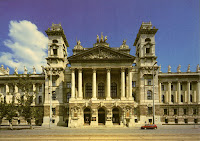
The following news does not have much to do with medieval art in Hungary, but it is a very significant discovery made at a Hungarian museum - specifically, at the Museum of Applied Arts, where I work - and I believe that the story is of interest to readers of this blog. So here it goes - the text below is based on the research and exhibition texts of Miklós Gálos, curator of the exhibition:
A rare, two-sided painting by Antonio Tempesta was rediscovered and restored at the Museum of Applied Arts in Budapest. The painting was painted on lapis lazuli, a rare and precious stone from the Middle East, which is the raw material of ultramarine, the marvelous deep blue color of paintings. This prestigious semi-precious stone was used by Antonio Tempesta, a painter active in the early 17th-century Rome, as support of paintings made for aristocratic patrons. Tempesta’s paintings on various types of stone are real curiosities. Only three paintings on lapis lazuli survived – one of them is housed in the Louvre in Paris, the other has recently been published by Alberto and Alessandra di Castro (the work is in private collection).
Another of them – a hitherto unknown lapis lazuli painting by Tempesta – was discovered in one of the storage areas of the Museum of Applied Arts some years ago. This work actually consists of two paintings: both sides of this thin, scarcely one-millimeter thick, translucent slab present scenes from the Old Testament. One side shows the Creation of Eve, and the other the Crossing of the Red Sea. Both depictions demonstrate a perfect collaboration between nature and art. The stone slab used as support is not painted on the entire surface, therefore, its color and patterns form an integral part of the depictions. The boundaries between the natural patterns of the stone and the artist’s work are imperceptible. The frame, with its mother-of-pearl inlays, is also unusual because of its complicated, contrived image field.
 |
| Antonio Tempesta: Crossing of the Red Sea (Museum of Applied Arts, Budapest) |
In January 2016, the artwork was discovered in a ruined state in one of the storage areas of the Museum of Applied Arts. The inlays of the broken frame were missing, and the stone support had been shattered with some pieces lost. Plaster infills made up a fifth of the painted surface. The shoddy inpainting on the plaster areas created a sharp contrast to the artistic quality of the original. The object did not appear in the museum’s inventory. During the next few years research managed to shed light on the provenance of the painting and later its deletion from the records. Fortunately, it was possible to determine the identities of the painter and, with considerable certainty, the original commissioner of the work. Thanks to the enthusiastic support of the Museum of Applied Arts’ Friends of the Museum, restoration was also carried out. The restoration of the lapis lazuli panel and the paintings on both sides was carried out by Ágnes Kuna. The frame was restored by Mária Szilágyi of the Museum of Applied Arts. As a result, this once-forgotten work of art has now regained its former glory.
 |
| Antonio Tempesta: Creation of Eve, during and after restoration (Museum of Applied Arts, Budapest) |
Now, the results of this work are presented to the public, in the form of a temporary exhibition at the György Ráth villa. Besides Tempesta’s painting, the exhibition includes some goldsmith works which, just like Tempesta’s painting, are examples of the fusion of an object of nature and an exceptional product of artistic talent. Like the Tempesta painting, the goldsmith works are from the former collection of Miklós Jankovich, a renowned Hungarian art collector of the early 19th century.
A detailed publication of the newly discovered Tempesta paintings - including a reconstruction of its history - was published by Miklós Gálos in volume 32 of Ars Decorativa, the Yearbook of the Museum of Applied Arts.
Miklós Gálos: An Antonio Tempesta Rediscovered in the Collection of the Museum of Applied Arts, Budapest, Ars Decorativa 32 (2018), 7-36.































